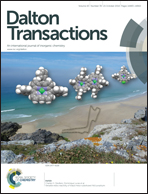Synthesis, crystal structures and magnetic behaviour of four coordination compounds constructed with a phosphinic amide-TEMPO radical and [M(hfac)2] (M = CuII, CoII and MnII)†
Abstract
In the present work we describe the synthesis, crystal structures and magnetic properties of four coordination compounds obtained by assembling a new phosphinic amide containing the TEMPO moiety, 1-piperidinyloxy-4-[(diphenylphosphinyl)amino]-2,2,6,6-tetramethyl radical (dppnTEMPO), with [M(hfac)2] building blocks (M = CuII, CoII, MnII). The crystal structures of the coordination compounds revealed the usefulness of the functionalized radical to provide discrete or extended architectures. In the copper compound (1) the ligand is coordinated through the oxygen atom of the NP![[double bond, length as m-dash]](https://www.rsc.org/images/entities/char_e001.gif) O linkage to the metal, which exists in a square pyramidal or octahedral geometry. For the cobalt and manganese complexes (2–4), both the phosphinic amide and the nitroxide oxygen atoms are involved in the coordination to the metal leading to one dimensional systems. In the cobalt complex (2) an interesting spin topology in the zig-zag chain was obtained due to the oxygen atom of the phosphinic amide group being μ2 coordinated to two cobalt(II) ions. The magnetic behaviour of the coordination compounds shows overall antiferromagnetic interactions involving the metal ion and the organic radical. DFT calculations were performed in order to assign the main path for the magnetic interactions.
O linkage to the metal, which exists in a square pyramidal or octahedral geometry. For the cobalt and manganese complexes (2–4), both the phosphinic amide and the nitroxide oxygen atoms are involved in the coordination to the metal leading to one dimensional systems. In the cobalt complex (2) an interesting spin topology in the zig-zag chain was obtained due to the oxygen atom of the phosphinic amide group being μ2 coordinated to two cobalt(II) ions. The magnetic behaviour of the coordination compounds shows overall antiferromagnetic interactions involving the metal ion and the organic radical. DFT calculations were performed in order to assign the main path for the magnetic interactions.
![Graphical abstract: Synthesis, crystal structures and magnetic behaviour of four coordination compounds constructed with a phosphinic amide-TEMPO radical and [M(hfac)2] (M = CuII, CoII and MnII)](/en/Image/Get?imageInfo.ImageType=GA&imageInfo.ImageIdentifier.ManuscriptID=C4DT01444H&imageInfo.ImageIdentifier.Year=2014)

 Please wait while we load your content...
Please wait while we load your content...